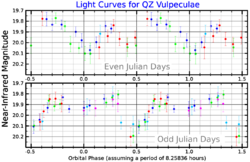Astronomy:GS 2000+25
From HandWiki
Short description: Star in the constellation Vulpecula
 Near-infrared (I band) light curves for QZ Vulpeculae, adapted from Chevalier and Ilovaisky (1993).[1] The data were collected over a 10 night period in July 1991. Data collected on different nights are plotted with different colors. The shape of the light curve changed over a period of approximately two days, leading to different shapes on even or odd numbered days. | |
| Observation data Equinox J2000.0]] (ICRS) | |
|---|---|
| Constellation | Vulpecula |
| Right ascension | 20h 02m 49.58s[2] |
| Declination | +25° 14′ 11.3″[2] |
| Apparent magnitude (V) | 18.2[2] |
| Characteristics | |
| Spectral type | Black hole + K3-6 V[3] |
| Astrometry | |
| Distance | 8800 ± 2300 ly (2700 ± 700[4] pc) |
| Orbit | |
| Period (P) | 8.26 hr[2] |
| Details | |
| Black hole | |
| Mass | 7.2–7.8[3] M☉ |
| Other designations | |
| Database references | |
| SIMBAD | data |
GS 2000+25 is an X-ray binary system in the constellation Vulpecula, consisting of a late K-type star and a black hole. It is also an X-ray nova.
Properties
Because the black hole is more massive than the companion star, it is the primary of the system. The black hole has a mass of about 5 solar masses while the companion has a mass of about 0.5 solar masses. Because the companion star has a low mass, the system is a low-mass X-ray binary.[6]
See also
References
- ↑ Chevalier, C.; Ilovaisky, S. A. (March 1993). "Optical studies of transient low-mass X-ray binaries. IV. A 10-hour distorsion wave in the quiescent light curve of GS 2000+25". Astronomy and Astrophysics 269: 301–309. Bibcode: 1993A&A...269..301C. https://ui.adsabs.harvard.edu/abs/1993A&A...269..301C. Retrieved 28 May 2022.
- ↑ 2.0 2.1 2.2 2.3 Liu, Q. Z; Van Paradijs, J; Van Den Heuvel, E. P. J (2007). "A catalogue of low-mass X-ray binaries in the Galaxy, LMC, and SMC (Fourth edition)". Astronomy & Astrophysics 469 (2): 807. doi:10.1051/0004-6361:20077303. Bibcode: 2007A&A...469..807L.
- ↑ 3.0 3.1 Yungelson, L; Lasota, J.-P (2008). "Evolution of low-mass binaries with black-hole components". New Astronomy Reviews 51 (10–12): 860–868. doi:10.1016/j.newar.2008.03.017. Bibcode: 2008NewAR..51..860Y.
- ↑ Reynolds, Mark T; Callanan, Paul J; Robinson, Edward L; Froning, Cynthia S (2008). "Infrared contamination in Galactic X-ray novae". Monthly Notices of the Royal Astronomical Society 387 (2): 788. doi:10.1111/j.1365-2966.2008.13272.x. Bibcode: 2008MNRAS.387..788R.
- ↑ "GS 2000+25". SIMBAD. Centre de données astronomiques de Strasbourg. http://simbad.u-strasbg.fr/simbad/sim-basic?Ident=GS+2000%2B25.
- ↑ Filippenko, Alexei V.; Matheson, Thomas; Barth, Aaron J. (1995). "A Black Hole in the X-Ray Nova GS 2000+25". Astrophysical Journal Letters 455 (2): L139. doi:10.1086/309831. Bibcode: 1995ApJ...455L.139F.
 |

